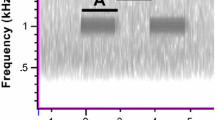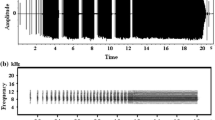Abstract
Two species of closely related wood cricket, Gryllus fultoni (Orthoptera: Gryllidae) and Gryllus vernalis, occur together in some parts of the eastern United States and have a similar calling song structure, consisting of three-pulse chirps. A previous study revealed that chirp rate in G. fultoni was highest (greatest difference vis-à-vis chirp rate in G. vernalis) in sympatric populations, intermediate in near allopatric populations that were located close to the sympatric zone, and lowest in allopatric populations. A similar trend was observed in pulse rate, but the mean values of this trait showed much more convergence than chirp rate at the low end of the range of calling temperatures. In this study, we investigated the song discrimination of females from sympatric and allopatric populations of G. fultoni at about 23°C, which is near the middle of the normal range of calling temperatures. We used both single-stimulus and two-stimulus playback experiments to learn if geographical differences in song preferences paralleled those in calling songs. Stimuli presented were representative of calling songs in three classes of G. fultoni populations (sympatric, near allopatric, and far allopatric), a calling song of G. vernalis, and three calling songs with parameter values that were intermediate with respect to those of the songs of far allopatric G. fultoni and G. vernalis. In the single-stimulus playbacks, females of all G. fultoni populations responded poorly if at all to the heterospecific stimulus. Females of sympatric and near allopatric populations responded poorly to all intermediate stimuli, but females of far allopatric populations frequently responded to these sounds. In the two-stimulus playbacks, females of sympatric and near allopatric populations generally discriminated against intermediate and heterospecific stimuli. However, females of far allopatric populations often did not discriminate against intermediate stimuli, whose characteristics resembled the calling songs of G. vernalis. The divergent pattern of female phonotactic discrimination between sympatric and far allopatric populations was thus generally congruent with the pattern of divergence in chirp and pulse rates and would be expected to significantly reduce heterospecific mating in sympatry. These geographical patterns of female song discrimination and male calling songs conform to a commonly used definition of reproductive character displacement.



Similar content being viewed by others
References
Alexander RD (1957) The taxonomy of the field crickets of the eastern United States (Orthoptera: Gryllidae: Acheta). Ann Entomol Soc Am 50:584–602
Alexander RD (1968) Life cycle origins, speciation, and related phenomena in crickets. Q Rev Biol 43:1–41
Bell WJ (1991) Searching behavior. Chapman & Hall, London, UK
Blair WF (1955) Mating call and stage of speciation in the Microhyla oliveacea–M. carolinensis complex. Evolution 9:469–480
Brooks R, Hunt J, Blows MW, Smith MJ, Bussiere LF, Jennions MD (2005) Experimental evidence for multivariate stabilizing sexual selection. Evolution 59:871–880
Brown WL, Wilson EO (1956) Character displacement. Syst Zool 5:49–64
Cade WH, Otte D (2000) Gryllus texensis n. sp.: a widely studied field cricket (Orthoptera: Gryllidae) from the southern United States. Trans Am Entomol Soc 126:117–123
Cade WH, Tyshenko MG (1990) Geographic variation in hybrid fertility in the field crickets Gryllus integer, Gryllus rubens, and Gryllus sp. Can J Zool 68:2697–2700
Doherty JA (1985) Phonotaxis in the cricket, Gryllus bimaculatus: Comparisons of choice and no-choice paradigms. J Comp Physiol A 157:279–290
Doherty JA, Callos JD (1991) Acoustic communication in the trilling field cricket, Gryllus rubens (Orthoptera: Gryllidea). J Insect Behav 4:67–81
Doherty JA, Storz MM (1992) Calling song and selective phonotaxis in the field crickets, Gryllus firmus and G. pennsylvanicus (Orthoptera: Gryllidae). J Insect Behav 5:555–569
Dobzhansky T (1940) Speciation as a stage in evolutionary divergence. Am Nat 74:312–321
Gabor CR, Ryan MJ (2001) Geographical variation in reproductive character displacement in mate choice by male sailfin molies. Proc R Soc Lond B 268:1063–1070
Gerhardt HC (1978) Temperature coupling in the vocal communication system of the gray tree frog Hyla versicolor. Science 199:992–994
Gerhardt HC (1999) Reproductive character displacement and other sources of environmental selection on acoustic communications systems. In: Hauser M, Konishi M (eds) The design of animal communication. MIT Press, Cambridge, MA, pp 515–534
Gerhardt HC, Huber F (2002) Acoustic communication in insects and anurans. Univ. of Chicago Press, Chicago, IL
Grant PR (1972) Convergent and divergent character displacement. Biol J Linn Soc 4:39–68
Gray DA (1999) Intrinsic factors affecting female choice in house crickets: time cost, female age, nutritional condition, body size, and size-relative reproductive investment. J Insect Behav 12:691–700
Gray DA, Cade WH (2000) Sexual selection and speciation in field crickets. Proc Natl Acad Sci U S A 97:14449–14454
Hennig RM, Weber T (1997) Filtering of temporal parameters of the calling song by cricket females of two closely related species: a behavioral analysis. J Comp Physiol A 180:621–630
Howard DS (1993) Reinforcement: origin, dynamics, and fate of an evolutionary hypothesis. In: Harrison RG (ed) Hybrid zones and the evolutionary process. Oxford Univ Press, Oxford, UK, pp 46–69
Höbel G, Gerhardt HC (2003) Reproductive character displacement in the acoustic communication system of green treefrogs (Hyla cinerea). Evolution 57:894–904
Huang Y, Ortí G, Sutherlin M, Duhachek A, Zera A (2000) Phylogenetic relationship of North American field crickets inferred from mitochondrial DNA data. Mol Phylogenet Evol 17:48–57
Jang Y, Gerhardt HC (2006) Divergence in the calling songs between sympatric and allopatric populations of the southern wood cricket Gryllus fultoni (Orthoptera: Gryllidae). J Evol Biol (in press)
Kelly JK, Noor MAF (1996) Speciation by reinforcement: a model derived from studies of Drosophila. Genetics 143:1485–1497
Kirkpatrick M (2000) Reinforcement and divergence under assortative mating. Proc R Soc Lond B 267:649–1655
Kirkpatrick M, Ravigné V (2002) Speciation by natural and sexual selection: models and experiments. Am Nat 159:S22–S35
Kirkpatrick M, Servedio MR (1999) The reinforcement of mating preferences on an island. Genetics 151:865–884
Lemmon AR, Smadja C, Kirkpatrick M (2004) Reproductive character displacement is not the only possible outcome of reinforcement. J Evol Biol 17:177–183
Liou LW, Price TD (1994) Speciation by reinforcement of premating isolation. Evolution 48:1451–1459
Marshall DC, Cooley JR (2000) Reproductive character displacement and speciation in periodical cicadas, with description of a new species, 13-year Magicicada neotredecim. Evolution 54:1313–1325
Noor MAF (1999) Reinforcement and other consequences of sympatry. Heredity 83:503–508
Prosser M, Murray AM, Cade WH (1997) The influence of female age on phonotaxis during single and multiple song presentations in the field cricket, Gryllus integer (Orthoptera: Gryllidae). J Insect Behav 10:437–449
Schul J, Bush SL (2002) Non-parallel coevolution of sender and receiver in the acoustic communication system of treefrogs. Proc R Soc Lond B 269:1847–1852
Servedio MR, Kirkpatrick M (1997) The effects of gene flow on reinforcement. Evolution 51:1764–1772
Servedio MR, Noor MAF (2003) The role of reinforcement in speciation: theory and data. Annu Rev Ecol Syst 34:339–364
Smith CJ, Cade WH (1987) Relative fertility in hybridization experiments using three song types of the field crickets Gryllus integer and Gryllus rubens. Can J Zool 65:2390–2394
Solymar BD, Cade WH (1990) Heritable variation for female mating frequency in field cricket, Gryllus integer. Behav Ecol Sociobiol 26:73–76
Stout JF, McGhee R (1988) Attractiveness of the male Acheta domestica calling song to females. J Comp Physiol A 164:277–287
Stout J, Walikonis R, Atkins G (1989) The influence of age and JHIII levels on the phonotactic response of female crickets (Acheta domesticus). In: Erber J, Menzel R, Pflüger HJd, Todt D (eds) Neural mechanisms of behavior. Thieme Medical, New York, NY, p 75
Thorson J, Weber T, Huber F (1982) Auditory behaviour of the cricket. II. Simplicity of calling-song recognition in Gryllus and anomalous phonotaxis at abnormal carrier frequencies. J Comp Physiol 146:361–378
Tynkkynen K, Rantala MJ, Suhonen J (2004) Interspecific aggression and character displacement in the damselfly Calopteryx splendens. J Evol Biol 17:759–767
Waage JK (1979) Reproductive character displacement in Calopteryx (Odonata: Calopterygidae). Evolution 33:104–116
Wagner WE Jr (1996) Convergent song preferences between female field crickets and acoustically orienting parasitoid flies. Behav Ecol 7:279–285
Wagner WE Jr (1998) Measuring female mating preferences. Anim Behav 55:1029–1042
Walker TJ (1974) Character displacement and acoustic insects. Am Zool 14:1137–1150
Walker TJ (1998) Trilling field crickets in a zone of overlap (Orthoptera: Gryllidae: Gryllus). Ann Entomol Soc Am 91:175–184
Walker TJ (2000) Pulse rates in the songs of trilling field crickets (Orthoptera: Gryllidae: Gryllus). Ann Entomol Soc Am 93:565–572
Walker TJ (2001) Singing insects of North America. http://buzz.ifas.ufl.edu
Acknowledgements
We thank A. Bockhorst for laboratory assistance. This work was supported financially by the University of Missouri Life Sciences Mission Enhancement Postdoctoral Fellowship to YJ and by a US National Science Foundation grant (IBN0091993) and a US National Institute of Health grant (NIH R01 DC05760) to HCG. The experiments in this study comply with the current law of the US.
Author information
Authors and Affiliations
Corresponding author
Additional information
Communicated by L. Simmons
Rights and permissions
About this article
Cite this article
Jang, Y., Gerhardt, H.C. Divergence in female calling song discrimination between sympatric and allopatric populations of the southern wood cricket Gryllus fultoni (Orthoptera: Gryllidae). Behav Ecol Sociobiol 60, 150–158 (2006). https://doi.org/10.1007/s00265-005-0151-3
Received:
Revised:
Accepted:
Published:
Issue Date:
DOI: https://doi.org/10.1007/s00265-005-0151-3




